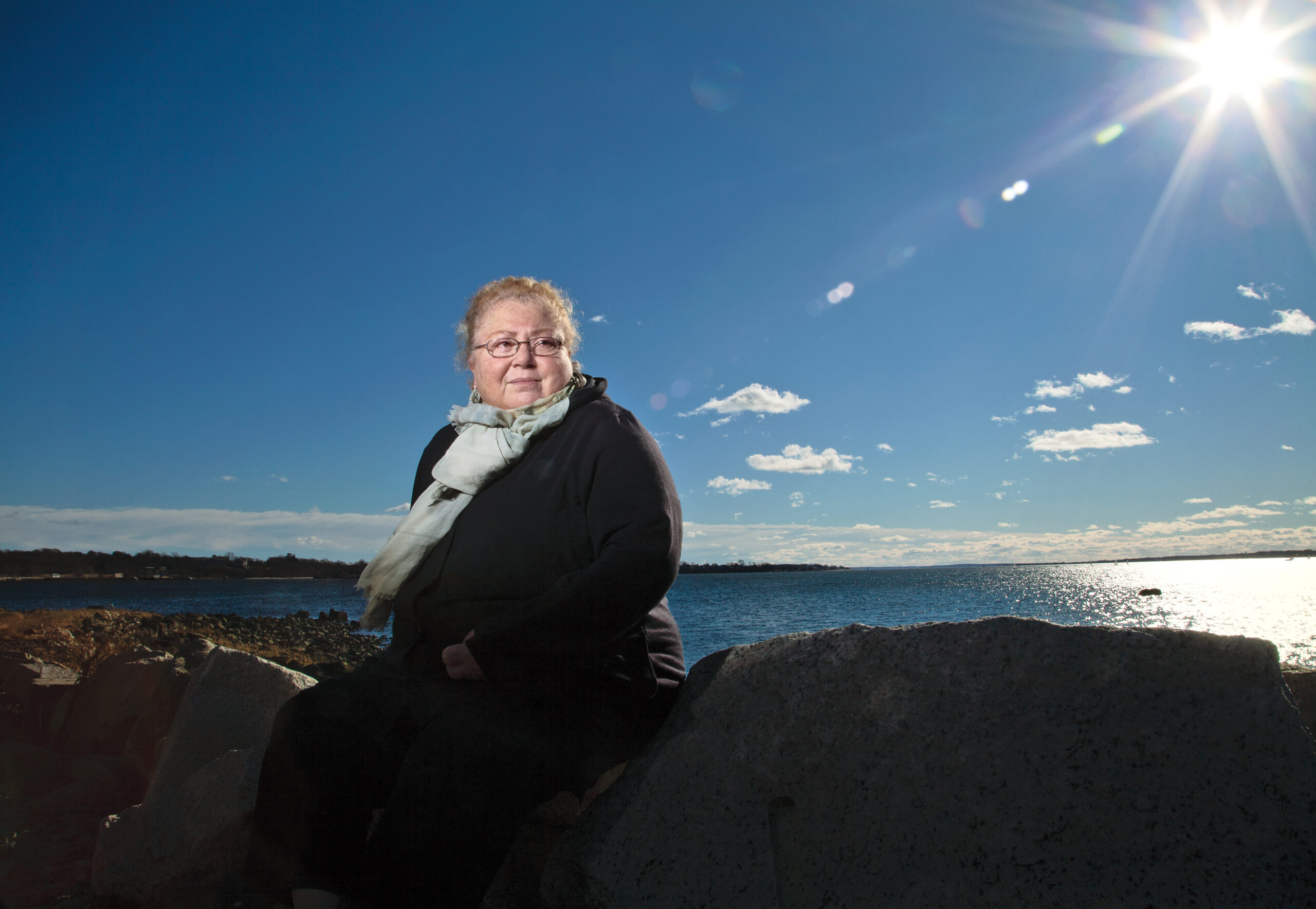South Providence’s “Slice of Water Access”
The end of Public Street, just off Allen’s Avenue in South Providence, earned its permanent protection as a Coastal Resources Management Council (CRMC)-designated shoreline right-of-way this past summer. But securing public access is only half the battle—making it attractive and usable is the other.
In such a densely urbanized area, every mile is subject to the pressure of many competing interests.
“The Coastal Resources Management Council has a goal, which we support, of having at least one public access point for every mile of shoreline in Rhode Island,” said Jed Thorp, advocacy coordinator for Save The Bay. “Right now, we have 225 or so public access points. But a lot of those access points aren’t in the metro Providence area. So, we have this neighborhood that’s very densely populated—probably the most densely populated neighborhood in the watershed—but [with] a real lack of public access locations.”
Using data from the American Community Survey 2012-2016, Julia Twichell, formerly watershed and GIS specialist for the Narragansett Bay Estuary Program, in collaboration with Kate Mulvaney, social scientist for the Environmental Protection Agency (EPA) Office of Research and Development, found that “there are state-wide inequities in coastal access opportunities associated with race and ethnicity.”
Their analysis examined Rhode Island’s public access through the lens of distributional justice, or the concept that both the benefits and burdens of environmental resources should be distributed fairly among all people, regardless of their race, gender, income, ethnicity, or other factors.
“A lot of the research that’s been done so far is focused on disamenities … pollution, contaminated sites [and] environmental hazards,” said Mulvaney in a webinar on the topic. “But when we’re thinking about distribution of resources, it’s also the good things, so parks, and other types of green space, where we put our restoration projects and money for restoration … and then also coastal access.”
This imbalance in public access isn’t random, says Elmwood educator and activist Doug Victor. Rather it’s a result of decades of chronic marginalization.
“It goes way back, because all of this was Native American land at one point, and Native Americans who used to fish there, and have access to do their worship rituals there, traditionally, were cut off from access,” Victor says. “All the other legacies are piled on top of that legacy. One of the legacies, I believe, is that of corporate America and how it has conducted itself and continues to conduct itself.”
Slater Mill, a water-powered textile mill in Pawtucket, is often cited as the birthplace of the Ame- rican Industrial Revolution. As textile manufacturing grew in Rhode Island, so did the local need for special metal tools, prompting the addition of metalworking businesses to the state.
According to Metal Inputs to Narragansett Bay by Scott Nixon, former Rhode Island Sea Grant director and University of Rhode Island professor of oceanography,
“The development and dramatic growth of textile manufacturing in Rhode Island and throughout the Blackstone River Valley is likely to have resulted in the first major increase in the addition of metals to Narragansett Bay.”

Linda Perri, a resident of Providence’s Southside and chair of the Washington Park Association, has long advocated for environmental justice for her community. Her efforts to expand and improve local public coastal access led to the designation of Public Street as a right-of-way to the shore. But that’s just the beginning of her plans for this area.
Following decades of industrialization, controlling the significant byproduct expelled by waterfront manufacturers proved necessary for both environmental and human health. With the creation of the Clean Water Act of 1972, the EPA developed the National Pollutant Discharge Elimination System. Both the national system and its Rhode Island branch, the Rhode Island Discharge Elimination System, seek to reduce water pollution by regulating the specific places, known as point sources, where pollutants are discharged into the water.
But recovering from centuries of pollution is intensive work. The EPA currently lists 12 of Rhode Island’s hazardous waste sites on its National Priorities List, seven of these being in Providence. The Toxics Action Center reports that “Providence has twice the national poverty rate and more hazardous waste sites and power plants than any other city in the state. The urban areas of Rhode Island are often the most over- burdened by toxic pollution.”
As commercial businesses gradually crowded the waterfront, access to the water became increasingly scarce. Where Providence residents could reach the water, it was in their best interest to stay dry—through the late 1900s, the Providence River had been an open sewer.
“Back in the 1990s, we were part of a taskforce on addressing the raw sewage overflow issue,” recalls Topher Hamblett, director of advocacy and policy at Save The Bay. “I remember back then, sitting around this table of community people, and there were some voices at that table that were saying, ‘we can’t afford to do this. These are urban rivers, and that’s just the way it is. You live in an urban area, too bad. We have other priorities in the state.’ And we reflexively just fought back against that. Regardless of who you are, and where you live, you have a right to clean water, period.”
The combined sewer overflow abatement project that began construction in the early 2000s dramatically improved water quality in upper Narragansett Bay, but other pollution problems remain for residents near the Port of Providence.
A fire last spring at an Allens Avenue scrap yard that had been cited for numerous pollution violations prompted a resolution by the Providence City Council calling for improved environmental oversight of port-area businesses that Councilman Pedro Espinal said in a statement “continue to pollute our neighborhoods and potentially our waterways.”

Public Street is one of the few designated rights-of-way in Providence thanks to the efforts of the Washington Park Association.
Photograph by Monica Allard Cox
“The industrial conglomerate … [is] trying to get away with anything they can get away with,” says Linda Perri, chair of the Washington Park Association. Perri was described by her colleague Victor as “Grand Central Station” for the concerns in her community, contesting any threats to her community’s rights and amplifying the voices of many.
One of her community’s concerns has been public shoreline access, and her advocacy helped lead to CRMC’s designation of Public Street as a right-of-way.
“We that live on the other end of Public Street, south of Public Street—there’s been this invisible line, so to speak, that we don’t matter. We don’t get public access, we don’t get waterfront access, because we’re in South Providence,” says Perri. “But that changed recently when the Attorney General advocated for us and CRMC [did]. And we got our little slice of water access.” “Identifying more opportunities for public access in places like that is very challenging, and I do think part of that is … a mindset,” adds Thorp. “It’s challenging to get decision-makers to think differently about a place like the Providence waterfront.”
This changing mindset includes a dedicated effort to listen and get to know community members, rather than implement policy from afar. For Leah Feldman, a policy analyst at CRMC working on public access for the agency, equitability is defined by face-to-face conversation.
“It’s a matter of not just dropping right in and then leaving, but instead, spending time with the community, figuring out what the rights-of-way are used for predominantly and what kinds of things need to be done to maintain the safety and the wellbeing of the right-of-way,” says Feldman.
“How many languages should the right-of-way signage be in? What kind of languages are predominant in this neighborhood? What kind of uses are predominant in this neighborhood?”
With this approach, Feldman hopes to work with urban and disadvantaged communities and partners like Save The Bay to not only restore public access but ensure that it is attractive and usable.
While plans for enhancing Public Street are still in early stages, Thorp and Perri have concrete ideas for next steps. Thorp points out the L-shaped unworked plot of land next to Public Street and behind the salt pile and suggests that if the city could somehow acquire use of part of that property, it could be transformed into a green space with picnic tables and other amenities for visiting families.
“Little by little, you know, step by step, I feel that we’re taking back our area,” says Perri.
Contact Us
Telephone: (401) 874-6805
Email: allard@uri.edu
Contributor Guidelines
Please review submission guidelines to be considered. d

